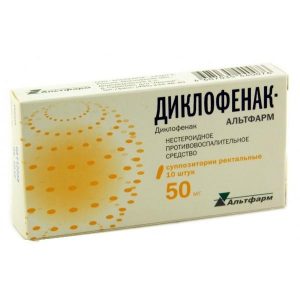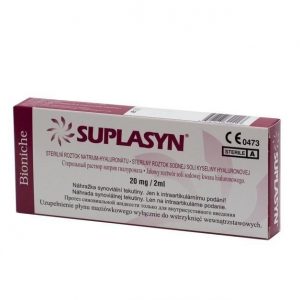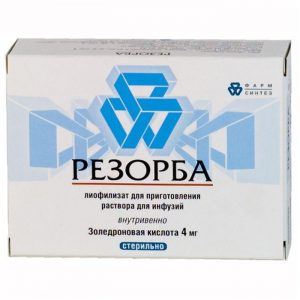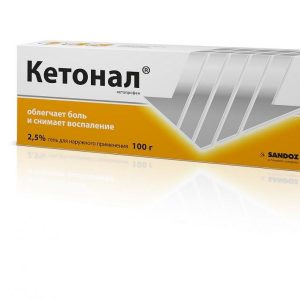Description
Pharmacological action
Non-steroidal anti-inflammatory drug, a derivative of phenylacetic and anti-inflammatory drugs, has an anti-inflammatory effect. Indiscriminately inhibiting cyclooxygenase 1 and cyclooxygenase 2, disrupts the metabolism of arachidonic acid, reduces the number of prostaglandins in the focus of inflammation.
Most effective for inflammatory pain. Like all non-steroidal anti-inflammatory drugs, the drug has an antiplatelet effect. In rheumatic diseases, the anti-inflammatory and analgesic effects of diclofenac significantly reduce the severity of pain, morning stiffness, swelling of the joints, which improves the functional state of the joint. With injuries in the postoperative period, diclofenac reduces pain and inflammatory edema.
Indications
Joint syndrome (rheumatoid arthritis, osteoarthritis, ankylosing spondylitis, gout), degenerative and chronic inflammatory diseases of the musculoskeletal system (osteochondrosis, osteoarthritis, periarthropathy), post-traumatic inflammation of the soft tissue and musculoskeletal system.
Pain in the spine, neuralgia, myalgia, arthralgia, pain and inflammation after operations and injuries, pain in gout, migraine, algodismenorrhea, pain in adnexitis, proctitis, colic (biliary and renal), pain in infectious and inflammatory diseases ENT organs.
For local use: inhibition of myosis during cataract surgery, prevention of cystoid macular edema associated with removal and implantation of the lens, inflammatory processes of the eye of non-infectious nature, post-traumatic inflammatory process with penetrating and non-penetrating injuries of the eyeball.
Contraindications
Hypersensitivity to the active substance or auxiliary components
Anamnestic data on an attack of bronchial obstruction, rhinitis, urticaria after taking acetylsalicylic acid or other NSAIDs (complete or incomplete intolerance syndrome of acetylsalipenic syrup, slynosylviclinic silynosilicin peptides, silynosilicin peptides, ulcerative changes in the gastric or duodenal mucosa, active gastrointestinal bleeding
Inflammatory bowel disease (non-specific minutes ulcerative colitis, Crohn’s disease)
period after aortocoronary bypass
III trimester of pregnancy, breastfeeding period
Uncompensated heart failure
Cerebrovascular bleeding or other bleeding and hemostatic disorders
Severe liver failure or active liver disease
Severe renal failure (creatinine clearance less than 30 ml / min), progressive kidney disease, i.e. confirmed hyperkalemia
Children under 6 years of age for 25 mg tablets, 50 mg tablets are contraindicated in children under 15 years of age.
Precautions:
Anemia, bronchial asthma, cerebrovascular disease, coronary heart disease, congestive heart failure, hypertension, peripheral artery disease, edema syndrome, liver or kidney failure, dyslipidemia / hyperlipidemia, diabetes mellitus, smoking, inflammatory bowel disease, condition after extensive surgery, induced porphyria, old age, diverticulitis, systemic connective tissue diseases, pregnancy I-II trimester, creatinine clearance less than 60 ml / min.
Special instructions
Use with extreme caution in case of diseases of the liver, kidneys, gastrointestinal tract in the anamnesis, dyspeptic symptoms, bronchial asthma, arterial hypertension, heart failure, immediately after serious surgical interventions, as well as in elderly patients.
For indications of a history of allergic reactions to NSAIDs and diclofenac sulfites, they are used only in urgent cases. During treatment, systematic monitoring of liver and kidney function is necessary, peripheral blood picture.
Rectal administration in patients with a history of anorectal disease or a history of anorectal bleeding is not recommended. Topically, it should be used only on intact skin areas.
Avoid contact with diclofenac in the eyes (with the exception of eye drops) or on the mucous membranes. Patients using contact lenses should apply eye drops no earlier than 5 minutes after removing the lenses.
Not recommended for use in children under 6 years of age.
Alcohol is not recommended during the period of treatment with dosage forms for systemic use.
Effect on the ability to drive vehicles and control mechanisms
During the treatment period, a decrease in the speed of psychomotor reactions is possible. If visual clarity deteriorates after applying eye drops, you should not drive or engage in other potentially hazardous activities.
Composition
Active ingredient: diclofenac sodium – 50 mg.
Excipients: colloidal silicon dioxide (aerosil), potato starch, crospovidone, calcium stearate, microcrystalline cellulose.
Auxiliaries for the shell: methacrylic acid and ethyl acrylate copolymer (Kollikut MAE P100), povidone (Kollidon 30), brown iron oxide, propylene glycol, talc, titanium dioxide, hydroxypropyl methylcellulose (hypromellose).
Dosage and administration
Inside, without chewing, during or after a meal, with a little water. Adults and adolescents from 15 years old – 25-50 mg 2-3 times a day.
When the optimal therapeutic effect is achieved, the dose is gradually reduced and switched to maintenance treatment at a dose of 50 mg / day. The maximum daily dose is 150 mg.
For children over 6 years old and adolescents, 25 mg tablets are used daily dose – 2 mg / kg of the child’s body weight, divided into 2-3 doses. In juvenile rheumatoid arthritis, the daily dose can be increased to 3 mg / kg body weight. Tablets should be taken whole, without chewing, on an empty stomach, with a small amount of liquid.
Side effects of the digestive system: nausea, vomiting, anorexia, pain and discomfort in the epigastric region, flatulence, constipation, diarrhea in some cases – erosive and ulcerative lesions, bleeding, bleeding rarely – impaired liver function. With rectal administration in rare cases, inflammation of the colon with bleeding, exacerbation of ulcerative colitis was noted.
From the side of the central nervous system and peripheral nervous system: dizziness, headache, agitation, insomnia, irritability, rarely tired feeling – paresthesia, visual impairment (vagueness, diplopia), tinnitus, sleep disturbances, cramps, irritability, tremors, mental disorders, depression.
From the hemopoietic system: rarely – anemia, leukopenia, thrombocytopenia, agranulocytosis.
From the urinary system: rarely – impaired renal function in susceptible patients, edema is possible.
Dermatological reactions: rarely – hair loss.
Allergic reactions: skin rash, itching when applied in the form of eye drops – itching, redness, photosensitivity.
Overdose
Symptoms: dizziness, headache, hyperventilation of the lungs, clouding of consciousness, in children – myoclonic cramps, nausea, vomiting, abdominal pain, bleeding, impaired liver and kidney function.
Treatment: gastric lavage, activated charcoal, symptomatic therapy aimed at eliminating the increase in blood pressure, impaired renal function, seizures, irritation of the gastrointestinal tract, respiratory depression. Forced diuresis, hemodialysis are ineffective.
Active ingredient
Diclofenac
pharmacy leave terms for prescription
lekarstvennaja form
tablets




